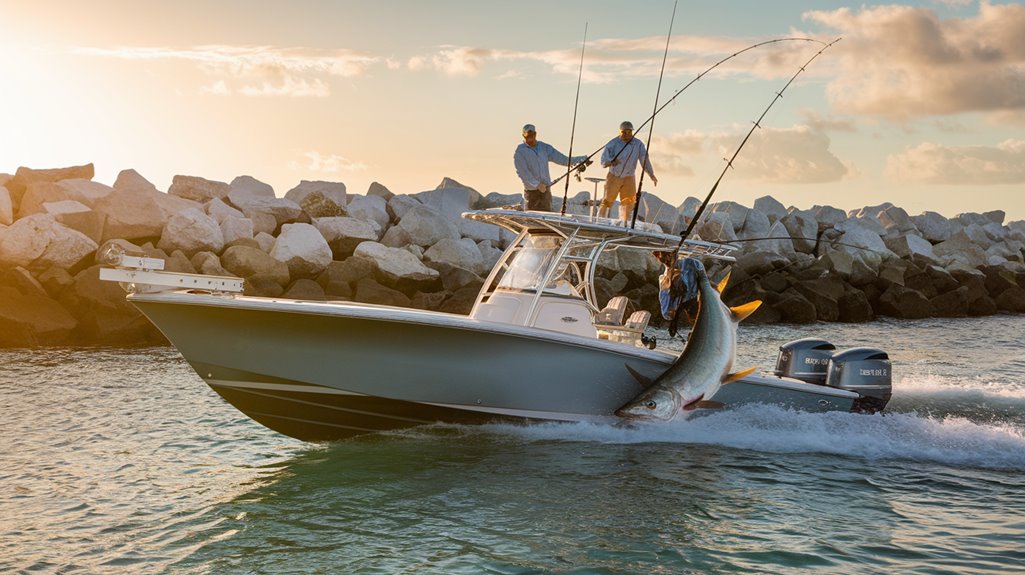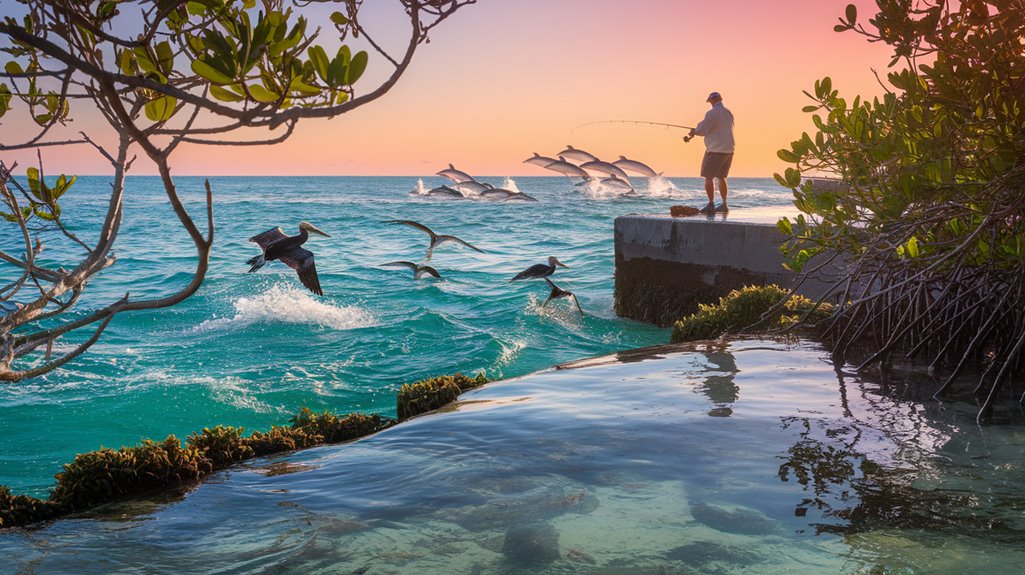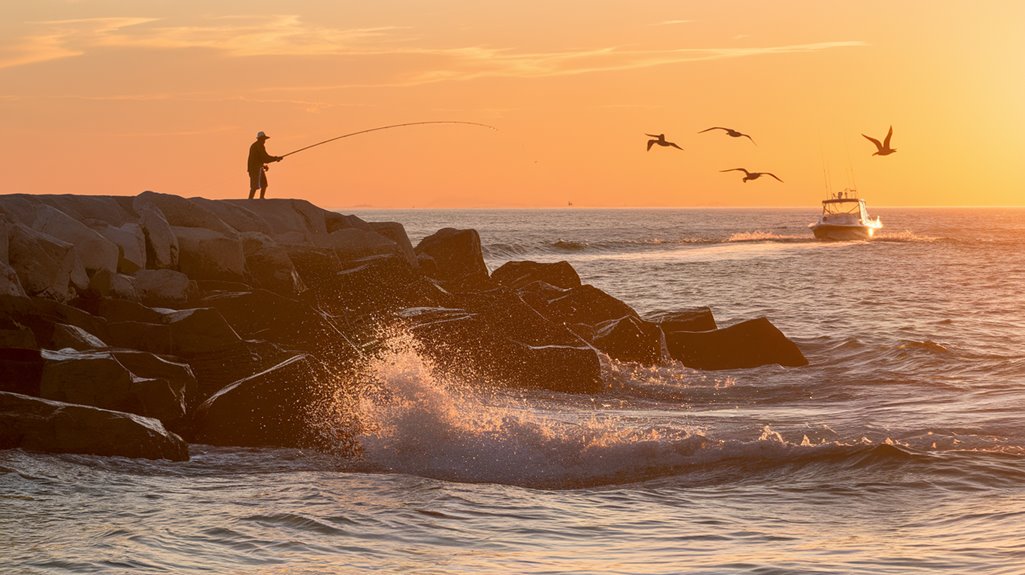You'll find Sebastian Inlet's reputation as Florida's premier fishing destination isn't just local folklore. Between the swift-moving tides of the jetties and the protected waters of the state park shoreline, you've got access to some of the most productive fishing grounds on the East Coast. Whether you're targeting trophy Snook during the spring migration or battling Black Drum in the deeper channels, understanding the inlet's unique characteristics can mean the difference between a casual outing and a memorable catch.
- Key Takeaways
- Discovering Sebastian Inlet's Prime Fishing Spots
- Essential Guide to Local Species and Seasons
- Expert Charter Services and Amenities
- Mastering Techniques for Inshore Success
- Equipment and Regulations for Your Adventure
- Wildlife Encounters and Natural Beauty
- Frequently Asked Questions
- Conclusion
Key Takeaways
- Sebastian Inlet offers prime fishing spots including jetties, river systems, and shorelines for diverse species like Snook, Flounder, and Redfish.
- Professional charter services provide expert guidance, equipment, licenses, and live bait for a hassle-free fishing experience.
- Peak fishing seasons occur April-May for Snook and Pompano, while Redfish and Black Drum remain available year-round.
- The area combines fishing opportunities with wildlife viewing, including dolphins, sea turtles, and diverse bird species.
- Optimal fishing times coincide with tide changes, with early morning and late afternoon yielding the best results.
Discovering Sebastian Inlet's Prime Fishing Spots
Whether you're an experienced angler or a casual fisherman, Sebastian Inlet offers some of Florida's most productive fishing spots throughout its diverse waterways. You'll find exceptional opportunities along both the North and South jetties, where Flounder congregate in impressive numbers. The Indian River and St. Sebastian River systems provide prime inshore fishing for Redfish and Snook, while the Sebastian Inlet State Park's shoreline offers excellent Black Drum fishing, especially during January's peak season.
Don't overlook the nearshore reefs and wrecks, where you can target Grouper and Snapper species. For the best results, time your visit during April and May when the warmer waters attract abundant Snook and Pompano. The inlet's unique geography creates perfect conditions for both inshore and offshore fishing, giving you multiple options for a successful day on the water.
Essential Guide to Local Species and Seasons
You'll find Sebastian Inlet's prime fishing calendar spans the full year, with snook dominating the warmer months from April through October and reaching peak activity during July and August's spawning season. For inshore action, you can target redfish and black drum year-round, while January brings excellent opportunities for bluefish. Whether you're working the inlet's waters or venturing 15 miles offshore, you'll encounter diverse species ranging from nearshore grouper and snapper to deep-water prizes like wahoo and mahi-mahi.
Peak Fishing Calendar Breakdown
While Sebastian Inlet's fishing opportunities remain strong year-round, understanding the peak seasons for different species can greatly boost your success rate. When planning your fishing trip on the Atlantic Ocean, you'll want to target specific months for ideal catches. Here's your essential monthly breakdown:
| Month | Target Species |
|---|---|
| January | Bluefish, Pompano, Black Drum, Shrimp |
| February | Blue Crab, Stone Crab, Bluefish |
| March | Bluefish, Shrimp (final runs) |
| April | Southern Flounder, Pompano, Snook |
| May | Snook, Pompano, Tarpon |
During peak season, you'll find the most productive fishing during early morning or late afternoon hours. Remember to check local regulations and obtain necessary permits before heading out to guarantee a successful and compliant expedition.
Target Species Hotspots
Sebastian Inlet offers three distinct fishing zones that consistently produce impressive catches throughout the year. At the inlet's mouth, you'll find prime target species hotspots for common snook, especially during their peak spawning months of July and August. For Inshore Half-Day Private Fishing, focus on the northern shoreline during winter months to catch redfish and black drum, while the southern shoreline excels for pompano in spring.
Fishing Techniques vary by zone and season: drift the channel edges for flounder in April, troll the nearshore waters for bluefish in March, and venture 15 miles offshore during summer for wahoo and mahi-mahi. The jetties provide year-round opportunities, but they're particularly productive for snook and tarpon when waters warm in May.
Expert Charter Services and Amenities

When planning your Sebastian Inlet fishing adventure, professional charter services like Kraken Down Charters provide extensive packages that elevate your experience from start to finish. Expert charter services handle all logistics, including fishing licenses and top-quality gear, so you'll focus solely on the thrill of the catch.
You'll benefit from personalized attention in small groups, guaranteeing maximum learning and enjoyment. Charter captains provide local knowledge and techniques suited to your skill level.
Key amenities include:
- Professional-grade rods and reels maintained for peak performance
- Fresh live bait selected for target species
- Complimentary ice and bottled water throughout your trip
- Expert fish filleting services
- All required licenses and permits arranged in advance
These all-encompassing services guarantee a safe, productive, and memorable fishing experience at Sebastian Inlet.
Mastering Techniques for Inshore Success
You'll maximize your inshore success at Sebastian Inlet by selecting fresh live bait like shrimp or pilchards, which prove irresistible to snook and other game fish. To optimize your fishing experience, time your outings around peak feeding periods during tide changes and the summer spawning months of July and August. Make sure you're equipped with medium-heavy spinning gear, 30-pound fluorocarbon leader, and circle hooks to effectively handle the powerful runs of inlet species while protecting both fish and tackle.
Live Bait Selection Tips
Choosing the right live bait is essential for targeting snook at Sebastian Inlet's diverse fishing grounds. Your success largely depends on selecting natural prey that snook actively pursue, such as pinfish, mullet, and shrimp. When rigging your live bait, use a weighted setup to keep it in the strike zone near bottom structure.
For best results at Sebastian Inlet, consider these critical factors:
- Match your bait selection to water temperature and salinity conditions
- Position your live bait near jetties and mangroves where snook ambush prey
- Maintain a slow, steady retrieve to mimic natural movement
- Focus your efforts during prime feeding times at dawn and dusk
- Use strong, fresh bait that exhibits lively movement to trigger strikes
Remember to monitor your live bait's condition and replace it when necessary to maintain its effectiveness as an attractant.
Targeting Peak Feeding Times
Successful inshore fishing at Sebastian Inlet depends heavily on understanding and targeting peak feeding times for gamefish species. You'll find the most productive fishing during dawn and dusk when snook are actively feeding. During these low-light periods, position yourself near structure with live bait for ideal results.
| Time | Activity Level | Best Tactics |
|---|---|---|
| Dawn | High | Live Pilchards |
| Mid-Morning | Moderate | Jerkbaits |
| Noon | Low | Deep Structure |
| Afternoon | Moderate | Bucktail Jigs |
| Dusk | High | Live Mullet |
Watch the tides carefully, as incoming water movements trigger increased feeding activity. You'll want to time your fishing during these periods, especially when they coincide with dawn or dusk. During warmer months, supplement your live bait approach with artificial lures to cover more water efficiently.
Optimal Gear Setup Essentials
When fishing Sebastian Inlet's inshore waters, a properly matched gear setup becomes critical for landing powerful gamefish like Snook and Redfish. Your success depends on selecting top-tier fishing gear that can handle the demanding conditions while complying with local fishing regulations.
Essential gear components for inshore waters include:
- High-quality rods matched to your target species' size and fighting strength
- Premium reels with smooth drag systems for battling powerful runs
- Strong, abrasion-resistant fishing line suitable for structure fishing
- Live bait setups with appropriate hook sizes and weights
- Specialized tackle configurations for different species and conditions
Remember to adjust your gear based on your target species and fishing location. Heavier tackle proves essential when pursuing larger fish near structures, while lighter setups work well for sight fishing in clear waters.
Equipment and Regulations for Your Adventure
The complete package at Sebastian Inlet charters takes the guesswork out of equipment and licensing requirements. You'll find top-of-the-line fishing gear ready for your use, with expert captains managing all regulatory compliance. They'll guarantee you're following local regulations while maximizing your chances of landing trophy fish.
| Equipment | Provided | Requirements |
|---|---|---|
| Rods & Reels | Yes | Maintained |
| Live Bait | Yes | Species-specific |
| Licenses | Included | Current |
| Safety Gear | Provided | Coast Guard approved |
Your captain will brief you on essential bag limits and size regulations for targeted species. With their expertise guiding you through proper equipment use and regulatory requirements, you can focus entirely on the thrill of fishing Sebastian Inlet's productive waters.
Wildlife Encounters and Natural Beauty

Beyond its reputation as a premier fishing destination, Sebastian Inlet serves as a natural sanctuary where you'll encounter an impressive array of marine life and coastal wildlife. The park's scenic trails and fishing docks offer prime spots for wildlife observation, where you can safely photograph dolphins, sea turtles, and diverse bird species in their natural habitat.
Key features that enhance your nature experience:
- Coastal wetlands teeming with native flora and fauna
- Tranquil waters perfect for observing marine life
- Well-maintained observation decks along the shoreline
- Protected estuaries showcasing Florida's biodiversity
- Opportunities to interact with local fishermen who share insights
While exploring these natural treasures, you'll discover how the local fishing culture harmoniously coexists with the area's remarkable ecosystem, creating an authentic Florida outdoor experience.
Frequently Asked Questions
Where Is the Best Fishing in Sebastian Inlet?
You'll find excellent fishing at the inlet's jetties, North Pier, and tide pools. For inshore action, target the Indian River's channels, while offshore reefs offer premium deep-water opportunities.
What's the Best Time to Fish at Sebastian Inlet?
You'll find peak fishing from January through May, with January offering Bluefish and Pompano, while April and May bring warmer waters ideal for Snook, Southern Flounder, and smaller Tarpon.
Is the Water Clear at Sebastian Inlet?
You'll find water clarity varies at Sebastian Inlet. It's typically clearest during dry weather and incoming tides. Visibility can range from crystal-clear to murky, depending on weather conditions and seasonal factors.
Can You Swim at Sebastian Inlet?
Yes, you can swim at Sebastian Inlet's designated areas, but you'll need to watch for strong currents. Stay near lifeguards during peak season and always check local conditions before entering the water.
Conclusion
While you might hesitate about Sebastian Inlet's strong currents, don't let that stop you from experiencing some of Florida's best fishing. With proper safety gear and local knowledge, you'll navigate these waters confidently. Whether you're casting from the jetties or joining a charter service, you'll find the inlet's diverse species and stunning coastal views make it worth every moment. Remember to check tide charts and weather conditions before heading out.

